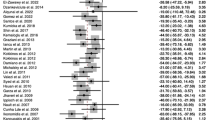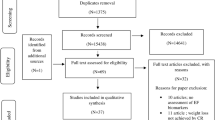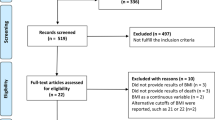Abstract
Background/Objectives:
Several studies confirmed a significantly increased carotid intima-media thickness (IMT) and impaired flow-mediated dilation (FMD) and nitrate-mediated dilation (NMD) in obese subjects, but few data are available on the effects of bariatric surgery on these markers of cardiovascular (CV) risk. We performed a meta-analysis of studies evaluating changes in IMT, FMD and NMD in obese patients after bariatric surgery.
Methods:
A systematic search was performed in the PubMed, Web of Science, Scopus and EMBASE databases without any language or publication year restriction. The last search was performed in January 2015. In addition, the reference lists of all retrieved articles were manually reviewed. Prospective studies evaluating the impact of bariatric surgery on the markers of CV risk were included. Changes in IMT, FMD and NMD after bariatric surgery were expressed as mean differences (MD) with pertinent 95% confidence intervals (95% CIs). IMT has been expressed in millimeters (mm); FMD and NMD as percentage (%). Impact of clinical and demographic features on effect size was assessed by meta-regression.
Results:
Ten articles (314 obese patients) were included in the analysis. Six studies contained data on IMT (7 data sets; 206 patients), 8 studies on FMD (9 data sets; 269 patients) and 4 on NMD (4 data sets; 149 patients). After bariatric surgery, there was a significant reduction of IMT (MD: −0.17 mm; 95% CI: −0.290, −0.049; P=0.006) and a significant improvement in FMD (MD: 5.65%; 95% CI: 2.87, 8.03; P<0.001), whereas NMD did not change (MD: 2.173%; 95% CI: −0.796, 5.142; P=0.151). Interestingly, percentage of changes in the body mass index were associated with changes in IMT (Z=11.52, P<0.001), FMD (Z=−4.26, P<0.001) and NMD (Z=−3.81, P<0.001).
Conclusions:
Despite heterogeneity among studies, bariatric surgery is associated with improvement of subclinical atherosclerosis and endothelial function. These effects may significantly contribute to the reduction of the CV risk after bariatric surgery.
This is a preview of subscription content, access via your institution
Access options
Subscribe to this journal
Receive 12 print issues and online access
$259.00 per year
only $21.58 per issue
Buy this article
- Purchase on Springer Link
- Instant access to full article PDF
Prices may be subject to local taxes which are calculated during checkout



Similar content being viewed by others
References
Kopelman PG . Obesity as a medical problem. Nature 2000; 404: 635–643.
Scaglione R, Argano C, Di Chiara T, Licata G . Obesity and cardiovascular risk: the new public health problem of worldwide proportions. Expert Rev Cardiovasc Ther 2004; 2: 203–212.
Poirier P, Giles TD, Bray GA, Hong Y, Stern JS, Pi-Sunyer FX et al. Obesity and cardiovascular disease: pathophysiology, evaluation, and effect of weight loss. Arterioscler Thromb Vasc Biol 2006; 26: 968–976.
Mingrone G, Panunzi S, De Gaetano A, Guidone C, Iaconelli A, Leccesi L et al. Bariatric surgery versus conventional medical therapy for type 2 diabetes. N Engl J Med 2012; 366: 1577–1585.
Calle EE, Kaaks R . Overweight, obesity and cancer: epidemiological evidence and proposed mechanisms. Nat Rev Cancer 2004; 4: 579–591.
Després JP, Lemieux I . Abdominal obesity and metabolic syndrome. Nature 2006; 444: 881–887.
Hubert HB, Feinleib M, McNamara PM, Castelli WP . Obesity as an independent risk factor for cardiovascular disease: a 26-year follow-up of participants in the Framingham Heart Study. Circulation 1983; 67: 968–977.
Malik S, Wong ND, Franklin SS, Kamath TV, L'Italien GJ, Pio JR et al. Impact of the metabolic syndrome on mortality from coronary heart disease, cardiovascular disease, and all causes in United States adults. Circulation 2004; 110: 1245–1250.
Caballero AE . Endothelial dysfunction in obesity and insulin resistance: a road to diabetes and heart disease. Obes Res 2003; 11: 1278–1289.
Williams IL, Chowienczyk PJ, Wheatcroft SB, Patel AG, Sherwood RA, Momin A et al. Endothelial function and weight loss in obese humans. Obes Surg 2005; 15: 1055–1060.
Lorenz MW, Markus HS, Bots ML, Rosvall M, Sitzer M . Prediction of clinical cardiovascular events with carotid intima-media thickness: a systematic review and meta-analysis. Circulation 2007; 115: 459–467.
Chan SY, Mancini GB, Kuramoto L, Schulzer M, Frohlich J, Ignaszewski A . The prognostic importance of endothelial dysfunction and carotid atheroma burden in patients with coronary artery disease. J Am Coll Cardiol 2003; 42: 1037–1043.
Bots ML, Grobbee DE . Intima media thickness as a surrogate marker for generalised atherosclerosis. Cardiovasc Drugs Ther 2002; 16: 341–351.
de Groot E, Hovingh GK, Wiegman A, Duriez P, Smit AJ, Fruchart JC et al. Measurement of arterial wall thickness as a surrogate marker for atherosclerosis. Circulation 2004; 109 (23 Suppl 1): III33–III38.
O’Leary DH, Polak JF, Kronmal RA, Manolio TA, Burke GL, Wolfson SK Jr . Carotid-artery intima and media thickness as a risk factor for myocardial infarction and stroke in older adults. Cardiovascular Health Study Collaborative Research Group. N Engl J Med 1999; 340: 14–22.
Chambless LE, Heiss G, Folsom AR, Rosamond W, Szklo M, Sharrett AR et al. Association of coronary heart disease incidence with carotid arterial wall thickness and major risk factors: the Atherosclerosis Risk in Communities (ARIC) Study, 1987-1993. Am J Epidemiol 1997; 146: 483–494.
Yeboah J, Folsom AR, Burke GL, Johnson C, Polak JF, Post W et al. Predictive value of brachial flow-mediated dilation for incident cardiovascular events in a population-based study: the multi-ethnic study of atherosclerosis. Circulation 2009; 120: 502–509.
Akamatsu D, Sato A, Goto H, Watanabe T, Hashimoto M, Shimizu T et al. Nitroglycerin-mediated vasodilatation of the brachial artery may predict long-term cardiovascular events irrespective of the presence of atherosclerotic disease. J Atheroscler Thromb 2010; 17: 1266–1274.
Schauer PR, Kashyap SR, Wolski K, Brethauer SA, Kirwan JP, Pothier CE et al. Bariatric surgery versus intensive medical therapy in obese patients with diabetes. N Engl J Med 2012; 366: 1567–1576.
Moher D, Liberati A, Tetzlaff J, Altman DG . Preferred reporting items for systematic reviews and meta-analyses: the PRISMA statement. PLoS Med 2009; 6: e1000097.
Juni P, Witschi A, Bloch R, Egger M . The hazards of scoring the quality of clinical trials for meta-analysis. JAMA 1999; 282: 1054–1060.
Sterne JA, Egger M, Smith GD . Systematic reviews in health care: investigating and dealing with publication and other biases in meta-analysis. BMJ 2001; 323: 101–105.
Gokce N, Vita JA, McDonnell M, Forse AR, Istfan N, Stoeckl M et al. Effect of medical and surgical weight loss on endothelial vasomotor function in obese patients. Am J Cardiol 2005; 95: 266–268.
Lind L, Zethelius B, Sundbom M, Edén Engström B, Karlsson FA . Vasoreactivity is rapidly improved in obese subjects after gastric bypass surgery. Int J Obes (Lond) 2009; 33: 1390–1395.
Sarmento PL, Plavnik FL, Zanella MT, Pinto PE, Miranda RB, Ajzen SA . Association of carotid intima-media thickness and cardiovascular risk factors in women pre- and post-bariatric surgery. Obes Surg 2009; 19: 339–344.
Habib P, Scrocco JD, Terek M, Vanek V, Mikolich JR . Effects of bariatric surgery on inflammatory, functional and structural markers of coronary atherosclerosis. Am J Cardiol 2009; 104: 1251–1255.
Brethauer SA, Heneghan HM, Eldar S, Gatmaitan P, Huang H, Kashyap S et al. Early effects of gastric bypass on endothelial function, inflammation, and cardiovascular risk in obese patients. Surg Endosc 2011; 25: 2650–2659.
Saleh MH, Bertolami MC, Assef JE, Taha MI, de Freitas W Jr, Petisco AC et al. Improvement of atherosclerotic markers in non-diabetic patients after bariatric surgery. Obes Surg 2012; 22: 1701–1707.
Tschoner A, Sturm W, Gelsinger C, Ress C, Laimer M, Engl J et al. Long-term effects of weight loss after bariatric surgery on functional and structural markers of atherosclerosis. Obesity (Silver Spring) 2013; 21: 1960–1965.
Sturm W, Tschoner A, Engl J, Kaser S, Laimer M, Ciardi C et al. Effect of bariatric surgery on both functional and structural measures of premature atherosclerosis. Eur Heart J 2009; 30: 2038–2043.
Nerla R, Tarzia P, Sestito A, Di Monaco A, Infusino F, Matera D et al. Effect of bariatric surgery on peripheral flow-mediated dilation and coronary microvascular function. Nutr Metab Cardiovasc Dis 2012; 22: 626–634.
García G, Bunout D, Mella J, Quiroga E, de la Maza MP, Cavada G et al. Bariatric surgery decreases carotid intima-media thickness in obese subjects. Nutr Hosp 2013; 28: 1102–1108.
Mackinnon AD, Jerrard-Dunne P, Sitzer M, Buehler A, von Kegler S, Markus HS . Rates and determinants of site-specific progression of carotid artery intimamedia thickness: the carotid atherosclerosis progression study. Stroke 2004; 35: 2150–2154.
de Groot E, van Leuven SI, Duivenvoorden R, Meuwese MC, Akdim F, Bots ML et al. Measurement of carotid intima-media thickness to assess progression and regression of atherosclerosis. Nat Clin Pract Cardiovasc Med 2008; 5: 280–288.
Scuteri A, Najjar SS, Muller DC, Andres R, Hougaku H, Metter EJ et al. Metabolic syndrome amplifies the age-associated increases in vascular thickness and stiffness. J Am Coll Cardiol 2004; 43: 1388–1395.
Tzou WS, Douglas PS, Srinivasan SR, Bond MG, Tang R, Chen W et al. Increased subclinical atherosclerosis in young adults with metabolic syndrome: the Bogalusa Heart Study. J Am Coll Cardiol 2005; 46: 457–463.
Shimbo D, Grahame-Clarke C, Miyake Y, Rodriguez C, Sciacca R, Di Tullio M et al. The association between endothelial dysfunction and cardiovascular outcomes in a population-based multi-ethnic cohort. Atherosclerosis 2007; 192: 197–203.
Kobayashi K, Akishita M, Yu W, Hashimoto M, Ohni M, Toba K . Interrelationship between non-invasive measurements of atherosclerosis: flow-mediated dilation of brachial artery, carotid intima-media thickness and pulse wave velocity. Atherosclerosis 2004; 173: 13–18.
Celermajer DS, Sorensen KE, Bull C, Robinson J, Deanfield JE . Endothelium dependent dilation in the systemic arteries of asymptomatic subjects relates to coronary risk factors and their interaction. J Am Coll Cardiol 1994; 24: 1468–1474.
Neunteufl T, Katzenschlager R, Hassan A, Klaar U, Schwarzacher S, Glogar D et al. Systemic endothelial dysfunction is related to the extent and severity of coronary artery disease. Atherosclerosis 1997; 129: 111–118.
Gloy VL, Briel M, Bhatt DL, Kashyap SR, Schauer PR, Mingrone G et al. Bariatric surgery versus non-surgical treatment for obesity: a systematic review and meta-analysis of randomised controlled trials. BMJ 2013; 347: f5934.
Vest AR, Heneghan HM, Agarwal S, Schauer PR, Young JB . Bariatric surgery and cardiovascular outcomes: a systematic review. Heart 2012; 98: 1763–1777.
Lupoli R, Milone M, Di Minno A, Maietta P, Ambrosino P, Musella M et al. Haemostatic and fibrinolytic changes in obese subjects undergoing bariatric surgery: the effect of different surgical procedures. Blood Transfus 2015; 13: 442–447.
Zagorski SM, Papa NN, Chung MH . The effect of weight loss after gastric bypass on C-reactive protein levels. Surg Obes Relat Dis 2005; 1: 81–85.
Yudkin JS, Stehouwer CDA, Emeis JJ, Coppack SW . C-reactive protein in healthy subjects: associations with obesity, insulin resistance, and endothelial dysfunction: a potential role for cytokines originating from adipose tissue? Arterioscler Thromb Vasc Biol 1999; 19: 972–978.
Rao SR . Inflammatory markers and bariatric surgery: a meta-analysis. Inflamm Res 2012; 61: 789–807.
Plavnik FL, Ajzen S, Kohlmann O Jr, Tavares A, Zanella MT, Ribeiro AB et al. Intima-media thickness evaluation by B-mode ultrasound. Correlation with blood pressure levels and cardiac structures. Braz J Med Biol Res 2000; 33: 55–64.
Reaven G . Role of insulin resistance in human disease. Diabetes 1988; 37: 1595–1607.
Ford ES . Risks for all-cause mortality, cardiovascular disease, and diabetes associated with the metabolic syndrome: a summary of the evidence. Diabetes Care 2005; 28: 1769–1778.
Rutter MK, Meigs JB, Sullivan LM, D’Agostino RB Sr, Wilson PW . Insulin resistance, the metabolic syndrome, and incident cardiovascular events in the Framingham Offspring Study. Diabetes 2005; 54: 3252–3257.
Howard G, O'Leary DH, Zaccaro D, Haffner S, Rewers M, Hamman R et al. Insulin sensitivity and atherosclerosis. The Insulin Resistance Atherosclerosis Study (IRAS) Investigators. Circulation 1996; 93: 1809–1817.
Cardellini M, Marini MA, Frontoni S, Hribal ML, Andreozzi F, Perticone F et al. Carotid artery intima-media thickness is associated with insulin-mediated glucose disposal in nondiabetic normotensive offspring of type 2 diabetic patients. Am J Physiol Endocrinol Metab 2007; 292: E347–E352.
Shai I, Spence JD, Schwarzfuchs D, Henkin Y, Parraga G, Rudich A et al. Dietary intervention to reverse carotid atherosclerosis. Circulation 2010; 121: 1200–1208.
Rafieian-Kopaei M, Setorki M, Doudi M, Baradaran A, Nasri H . Atherosclerosis: process, indicators, risk factors and new hopes. Int J Prev Med 2014; 5: 927–946.
Kelly DM, Jones TH . Testosterone and cardiovascular risk in men. Front Horm Res 2014; 43: 1–20.
Walker AE, Eskurza I, Pierce GL, Gates PE, Seals DR . Modulation of vascular endothelial function by low-density lipoprotein cholesterol with aging: influence of habitual exercise. Am J Hypertens 2009; 22: 250–256.
Walther G, Obert P, Dutheil F, Chapier R, Lesourd B, Naughton G et al. Metabolic syndrome individuals with and without type 2 diabetes mellitus present generalized vascular dysfunction: cross-sectional study. Arterioscler Thromb Vasc Biol 2015; 35: 1022–1029.
Pomero F, Di Minno MN, Fenoglio L, Gianni M, Ageno W, Dentali F . Is diabetes a hypercoagulable state? A critical appraisal. Acta Diabetol 2015. e-pub ahead of print 9 April 2015.
Ricci C, Gaeta M, Rausa E, Macchitella Y, Bonavina L . Early impact of bariatric surgery on type II diabetes, hypertension, and hyperlipidemia: a systematic review, meta-analysis and meta-regression on 6,587 patients. Obes Surg 2014; 24: 522–528.
Soltész P, Kerekes G, Dér H, Szücs G, Szántó S, Kiss E et al. Comparative assessment of vascular function in autoimmune rheumatic diseases: considerations of prevention and treatment. Autoimmun Rev 2011; 10: 416–425.
Author information
Authors and Affiliations
Corresponding author
Ethics declarations
Competing interests
The authors declare no conflict of interest.
Additional information
Supplementary Information accompanies this paper on International Journal of Obesity website
Supplementary information
Rights and permissions
About this article
Cite this article
Lupoli, R., Di Minno, M., Guidone, C. et al. Effects of bariatric surgery on markers of subclinical atherosclerosis and endothelial function: a meta-analysis of literature studies. Int J Obes 40, 395–402 (2016). https://doi.org/10.1038/ijo.2015.187
Received:
Revised:
Accepted:
Published:
Issue Date:
DOI: https://doi.org/10.1038/ijo.2015.187
This article is cited by
-
Bariatric surgery prevents carotid wall thickness progression
Wiener klinische Wochenschrift (2023)
-
Impact of bariatric surgery on carotid intima-medial thickness and cardiovascular risk: results of a prospective study
Surgical Endoscopy (2021)
-
Skin Autofluorescence and Carotid Intima-Media Thickness Evaluation Following Bariatric Surgery in Patients with Severe Obesity
Obesity Surgery (2021)
-
Systematic Review and Meta-Analysis of the Impact of Bariatric Surgery on Lower Urinary Tract Symptoms in Males
Obesity Surgery (2021)
-
Medical and Surgical Obesity Treatments and Atherosclerosis: Mechanisms beyond Typical Risk Factors
Current Atherosclerosis Reports (2021)



